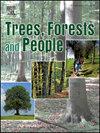海拔高度和地貌对喜马拉雅山脉柞树林固碳潜力的影响
IF 2.9
Q1 FORESTRY
引用次数: 0
摘要
森林是主要的固碳资源,有助于缓解大气碳的不利影响和减少全球变暖。本研究旨在估算柞树林在两个不同方面和三个海拔高度的固碳潜力。在每片森林中布置了 10 个 10 × 10 m 大小的四分点,用于估算林分密度和树木生物量,并在每个四分点采集土壤样本。花叶榕是研究海拔高度和海拔高度上的主要树种,在南面和北面的 IVI 值分别为 161.14 和 124.96。在南面和北面的高海拔地区(2500-2700 米),地上生物量密度(AGBD)、地下生物量密度(BGBD)、总生物量密度(TBD)和总碳密度(TCD)的值最高。南面的 AGBD 值(476.67 < 575.67 兆克/公顷)、BGBD 值(124.8 < 148.9 兆克/公顷)、TBD 值(601.53 < 724 兆克/公顷)和 TCD 值(300.83 < 362.03 兆克/公顷)均高于北面。高海拔地区的 AGBD、BGBD、TBD 和 TCD 值最大(分别为 638 兆克/公顷、163.1 兆克/公顷、800.5 兆克/公顷和 400.35 兆克/公顷)。土壤有机碳 (SOC)、土壤有机质 (SOM) 和土壤有机碳储量 (SOCS) 随海拔和深度的增加而减少,南面海拔较高。容重(BD)和钾随海拔和深度的增加而增加,但两侧的容重相同(1.29 克cc-1),而南侧的钾含量更高(31.43 千克/公顷)。最高的可利用氮(398 千克/公顷)出现在中海拔的北部地区。钾的可利用量在北部地区最高。在低海拔地区,可利用钾介于 246-615 公斤/公顷之间。所有地点的土壤 pH 值都呈弱酸性,不同土壤深度的 pH 值在 4.91 至 5.74 之间。从土壤下层到上层,脱氢酶活性介于 1.35 至 8.74 µg/g/h 之间,随着土壤深度的增加而降低,并随着海拔的增加而升高,而南面的土壤脱氢酶活性最高。本研究表明,花叶榕森林的树木密度、树木生物量、固碳潜力和土壤健康受到海拔高度和朝向的很大影响。这些发现为研究地区的气候变化减缓和森林管理策略提供了宝贵的见解。本文章由计算机程序翻译,如有差异,请以英文原文为准。
Effect of altitudes and aspects on carbon sequestration potential of Quercus floribunda forests of Garhwal Himalayas
The forests are major resources for carbon sequestration and help to mitigate the adverse effect of atmospheric carbon and reduce global warming. The present study was conducted to estimate the carbon sequestration potential of the Quercus floribunda forests at two different aspects and three altitudes. Ten quadrates of 10 × 10 m size were laid out in each forest for the estimation of stand density, tree biomass, and soil samples were collected from each quadrate. Q. floribunda was the dominating tree at studied altitudes and aspects with the IVI values of 161.14 and 124.96 in the southern aspect and northern aspects, respectively. the highest values of above-ground biomass density (AGBD), below-ground biomass density (BGBD), total biomass density (TBD), and total carbon density (TCD) was recorded at the upper elevation (2500–2700 m) of southern and northern aspects. In the southern aspect values of AGBD (476.67 < 575.67 Mg/ha), BGBD (124.8 < 148.9 Mg/ha), TBD (601.53 < 724 Mg/ha), TCD (300.83 < 362.03 Mg/ha) were higher than northern aspect. The values of AGBD, BGBD, TBD, and TCD were reported maximum (638 Mg/ha, 163.1 Mg/ha, 800.5 Mg/ha, and 400.35 Mg/ha; respectively) in the upper elevation. Soil organic carbon (SOC), soil organic matter (SOM), and soil organic carbon stock (SOCS) decreased with increasing altitudes and depths which were found higher in the southern aspect. Bulk density (BD) and P increased with altitudes and depth however bulk density was equal (1.29 g cc-1) in both aspects whereas P was also found higher (31.43 kg/ha) in the southern aspect. Highest available nitrogen (398 kg/ha) was recorded in the northern aspect at middle altitude. The available potassium was highest in the northern aspect. At lower altitudes, available potassium ranges between 246–615 kg/ha. Soil pH was found slightly acidic in all the sites ranging from 4.91 to 5.74 in different soil depths. Dehydrogenase activity was ranged between 1.35 and 8.74 µg/g/h from lower to upper soil depth and decreased with an increase in soil depths and increased with altitudes, whereas found highest in the southern aspect. The present study suggested that tree density, tree biomass, carbon sequestration potential, and soil health in Q. floribunda forests were substantially influenced by the altitude as well as the aspect. These findings contribute valuable insights for climate change mitigation and forest management strategies in the study region.
求助全文
通过发布文献求助,成功后即可免费获取论文全文。
去求助
来源期刊

Trees, Forests and People
Economics, Econometrics and Finance-Economics, Econometrics and Finance (miscellaneous)
CiteScore
4.30
自引率
7.40%
发文量
172
审稿时长
56 days
 求助内容:
求助内容: 应助结果提醒方式:
应助结果提醒方式:


